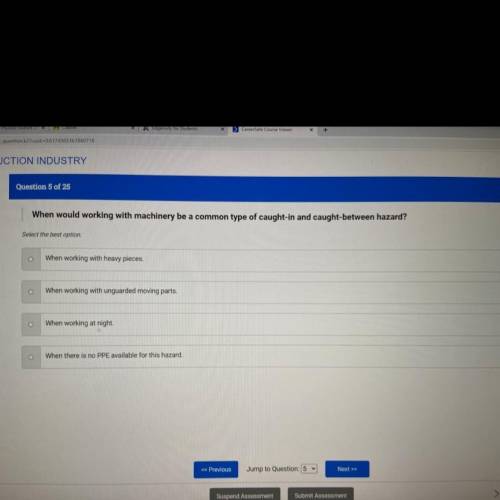
Engineering, 12.04.2021 23:30 alyssagonzales2021
When would working with machinery be a common type of caught-in and caught-between hazard? A: When working with heavy pieces. B: When working with unguarded moving parts. C: When working at night. D: When there is no PPE available for this hazard.


Answers: 2


Another question on Engineering

Engineering, 04.07.2019 18:10
If a particle moves along a path such that r : (3 sin t) m and ? : 2t rad, where t is in seconds. what is the particle's acceleration in m/s in 4 seconds? a)- 16.43 b)- 16.29 c)- 15.21 d)- 13.79
Answers: 1

Engineering, 04.07.2019 19:10
10 kg of co2 is initially contained at 400 kpa and 300 k. the gas constant for carbon dioxide is 189 j/lkg k) and has a specific heat ratio, k, of 1.289. isentropic expansion then occurs until the pressure is 200 kpa. a) determine the initial volume of co2 in m. b) determine the final temperature in k. c) determine the work done by the system during the expansion kl.
Answers: 2

Engineering, 04.07.2019 19:10
Asteel wire of 2 mm diameter is fixed between two points located 2 m apart. the tensile force in the wire is 250n, if its density of steel is given by 7830 kg/m3 the fundamental frequency of vibration hz? ?
Answers: 3

Engineering, 06.07.2019 03:10
Explain the strain-hardening phenomenon on the basis of dislocation - dislocation strain field interactions. also, briefly describe what generally happens to the ductility of a metal that has been strain hardened (i.e. does strain hardening make a metal more ductile or
Answers: 3
You know the right answer?
When would working with machinery be a common type of caught-in and caught-between hazard? A: When w...
Questions





Mathematics, 04.06.2021 22:40

History, 04.06.2021 22:40

Social Studies, 04.06.2021 22:40


Mathematics, 04.06.2021 22:40


Business, 04.06.2021 22:40

Spanish, 04.06.2021 22:40



Mathematics, 04.06.2021 22:40





Social Studies, 04.06.2021 22:40



